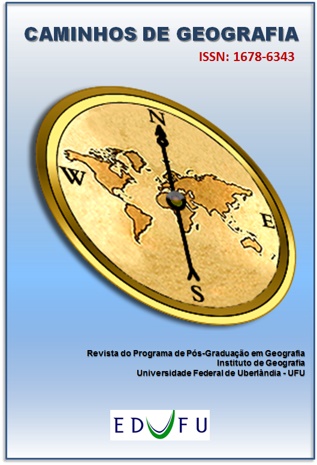TÉCNICAS DE ANÁLISE ESPACIAL NA IDENTIFICAÇÃO DE ÁREAS APTAS PARA A IMPLANTAÇÃO DE UM ATERRO SANITÁRIO NO MUNICÍPIO DE DIVINÓPOLIS, MINAS GERAIS
DOI:
https://doi.org/10.14393/RCG238658390Palavras-chave:
Geoprocessamento, Resíduos Sólidos, Sistemas de Informações GeográficasResumo
Atualmente um dos grandes desafios urbanos é a disposição adequada dos resíduos sólidos. O crescimento acelerado da população nos últimos anos vem causando inúmeros impactos ao meio ambiente, dentre eles, o descarte irregular de resíduos, tornando cada vez mais complexo o trabalho de encontrar um local ambientalmente viável ao descarte dos mesmos. Os aterros sanitários são as opções mais viáveis e seguras, pois, conseguem evitar a contaminação dos recursos hídricos, do ar e do solo. Porém, a escolha do local adequado para a construção de um aterro sanitário continua sendo um dos maiores problemas por todas as variáveis envolvidas. Assim, este artigo tem como objetivo determinar, através das ferramentas de geoprocessamento, áreas ideais para a implantação de aterros sanitários no município de Divinópolis – MG. Este objetivo foi alcançado por meio de Sistema de Informação Geográfica (SIG) e análise de Múltiplos Critérios. Os resultados mostraram que mais de 60% de toda a área do município possui áreas inviáveis à implementação de um aterro e que, aproximadamente, 27% de toda a área é considerada de adequabilidade média e, portanto, deveria ser analisada de maneira mais aprofundada.
Downloads
Downloads
Publicado
Edição
Seção
Licença
Copyright (c) 2022 Rick Max Aramaki, Daniel Pena Pereira, Amanda Santana dos Santos

Este trabalho está licenciado sob uma licença Creative Commons Attribution-NonCommercial-NoDerivatives 4.0 International License.
Autores que publicam nesta revista concordam com os seguintes termos: a) Autores mantém os direitos autorais e concedem à revista o direito de primeira publicação, com o trabalho licenciado sob a Creative Commons Atribuição-NãoComercial-SemDerivações 4.0 Internacional. b) Autores têm permissão e são estimulados a publicar e distribuir seu trabalho online (ex.: em repositórios institucionais ou na sua página pessoal), já que isso pode gerar alterações produtivas, bem como aumentar o impacto e a citação do trabalho publicado. c) Em virtude de aparecerem nesta revista de acesso público, os artigos são de uso gratuito, com atribuições próprias, em aplicações educacionais e não-comerciais.











